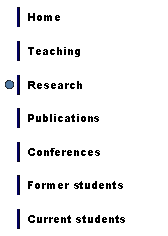|
Dr. Muhammad Aftab Rafiq |



|
Research interests |
|
* Micro/nanofabrication of devices for memory and information processing * Preparation of novel nanomaterials and nanodevices for applications in diverse fields such as information processing devices, humidity sensors, gas sensors and light detectors. * Solid state reaction method, co-precipitation technique and electrospinning are used to prepare nanoparticles, nanowires, nanoflakes and nanorods of semiconductor materials. * Simple devices are then fabricated to study electrical, sensing, and photodetection properties of these nanostructures. * Photocatalysis using nanomaterials * Materials modelling |
|
Phone: +92-51-9248702 Fax: +92-51-9248600 E-mail: aftabrafiq[at]pieas.edu.pk |
Research grants: |

|
* Two-dimensional transition metal dichalcogenide based photodetectors and quantum effect devices” by Pakistan Science Foundation and National Natural Science Foundation of China 2017(PI). * Metal oxide / sulphide nanostructures for environmental pollution detection, monitoring and remediation (17.57 million PKR) awarded by Higher Education Commission Islamabad Pakistan in 2016 * Start-up research grant program, Computational study of electronic, structural and optical properties of metal sulphides / oxides, (PKR 449,754/-) by HEC 2015. * British Council Researchers Links Travel grant 2014 (4285 UK pound) * Electron transport in silicon nanostructures (4.46 million PKR) awarded by Higher Education Commission Islamabad Pakistan in 2009 * Higher Education Commission Grant for Spare Parts / Maintenance of Equipment (1 million Pakistan Rupees). |
Current research topics : |
|
To contact me: |
Further information about my research: |
Research facilities: |
|
* Cryogenic probe station * Temperature can be varied from 77 K to 500 K * Precision semiconductor parameter analyzer Agilent 4156C * LCR meter Agilent E4980a * Keithley 2400 source meter * In-house built Electrospinning setup * In-house built setup to study ferroelectric properties * In-house built setup for photocatalysis * In-house built setup for gas sesning * Edwards E306 thermal evaporator * A 10 core FUJITSU workstation for materials modelling * Density functional theory code WEIN2k * The General Utility Lattice Program (GULP) to perform a variety of tasks based on force field methods * Small lab items such as ultrasonic bathe, pH meter, centrifuge, lock-in amplifier, nanovoltmeter, vacuum pumps, oscilloscopes, etc. * Box furnaces * XRD, SEM and thermal analysis facilities are available in collaborating laboratories |